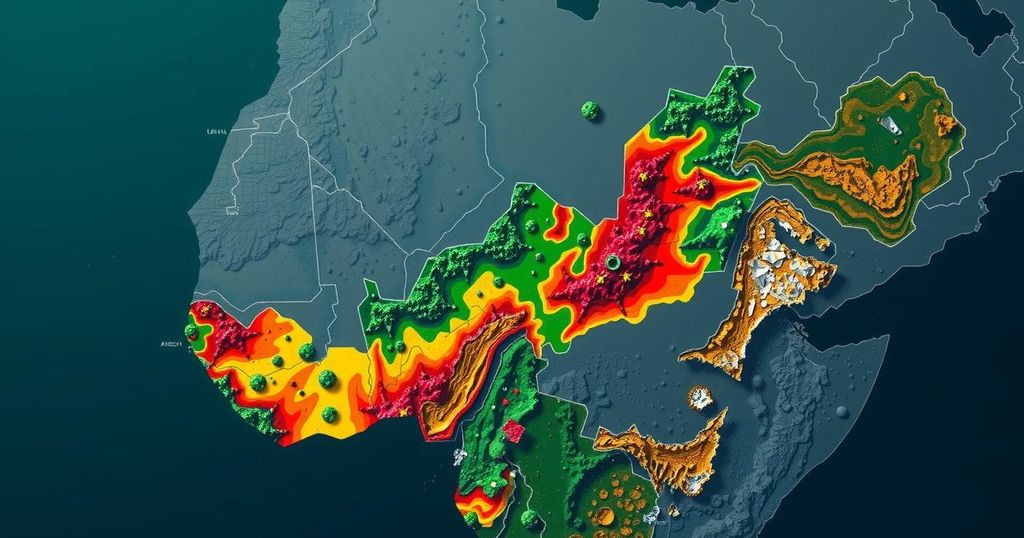Harnessing Development Minerals for Economic Diversification in Congo

The Republic of Congo is diversifying its economy through investment in development minerals, aiming to reduce dependence on oil. The government seeks to enhance infrastructure and boost GDP through untapped resources such as sand and gravel. Major projects are in motion, including the Sounda Dam and a railway bridge with the DRC. Upcoming events like the Congo Energy & Investment Forum will promote collaboration and investment in the mining sector, promising growth opportunities.
The Republic of Congo is actively pursuing diversification of its economy to lessen dependence on the oil sector through heightened investment in the mining industry. Emphasizing the development of minerals, which include vital industrial and construction materials, the government recognizes the immense potential for enhancing infrastructure projects. With proper organization and sustainable management, the mining sector could not only boost GDP contributions but also catalyze long-term economic growth and overall advancement in the region.
Regrettably, the artisanal production of these development minerals remains significantly under-utilized, as revealed by a 2024 joint study conducted by the Congolese government and the UN Development Program. The findings indicate that the total production of sand and rubble was recorded at 113,498 cubic meters and 86,984 cubic meters, respectively. This underperformance underscores a strategic investment opportunity to fully harness these resources’ potential for contributing to the economic stature of Congo.
Development minerals such as sand, stone, and gravel play a critical role in infrastructure development, essential for constructing roads, bridges, and public facilities. They are equally beneficial to the energy sector, facilitating energy production, site construction, and improving hydrocarbon transportation. The Congolese government has initiated major infrastructure endeavors, such as the Sounda Dam construction authorized in November 2024, anticipated to generate between 600 MW to 800 MW of electricity and expected to commence in January 2025. Additionally, a €150 million bulk cargo port project has been approved to enhance industrial activities in the Pointe-Noire Special Economic Zone, focusing on timber and agriproduct processing.
Plans are also underway for a railway bridge connecting Brazzaville and Kinshasa, set to begin construction within a year. This bridge is projected to manage the movement of over 5 million passengers and 3 million tons of goods annually by the close of 2025, marking a significant regional corridor. Furthermore, a partnership with Russia led to the approval of an oil pipeline construction linking Pointe-Noire, Brazzaville, and Oyo in September 2024. Structured production initiatives for sand and stone, as highlighted in the UNDP report, could significantly reduce infrastructure costs and promote sustainable resource management.
In addition to development minerals, Congo is rich in untapped mining resources, including iron ore, copper, gold, and potash. Noteworthy projects such as the Mbalam-Nabeba iron ore project by Australian miner Sundance Resources, and the Mayoko project by Sapro, which produced its first 800 tons of iron ore in August 2024, illustrate the vibrancy of the sector. The Zanaga iron ore project’s promising feasibility study aims for an annual production rate of 30 million tons, signifying a positive outlook for the iron ore sector’s future.
The Congo’s potential within the development minerals and wider mining sector promises significant sustainable growth opportunities. The upcoming Congo Energy & Investment Forum, scheduled for March 25-26 in Brazzaville, promises to be a pivotal gathering for stakeholders to explore investment possibilities and collaborative efforts in infrastructure and mining, thereby positioning the Republic of Congo as a crucial player in Africa’s economic transformation.
The Republic of Congo, heavily reliant on the oil sector, is shifting its focus towards diversifying its economic landscape by investing in the mining industry, particularly development minerals, which include essential materials for industrial and construction purposes. The meaningful utilization of these resources is seen as a key driver of infrastructure improvements and overall economic growth. However, the artisanal production of these minerals is not fully optimized. Enhancing organization and management practices within this sector could greatly contribute to the nation’s financial development, positioning the Republic of Congo favorably on the African continent. Major infrastructure projects, alongside additional mining initiatives, signify a proactive approach towards sustainable growth, making the Congo Energy & Investment Forum an ideal platform to foster discussions on these developments.
In conclusion, the Republic of Congo is strategically working to diversify its economy through increased investment in development minerals, highlighting their crucial role in infrastructure and energy projects. While the under-utilization of artisanal production presents a challenge, there are ample opportunities for growth in this sector. The upcoming Congo Energy & Investment Forum stands to promote investments that can enhance the mining landscape and support sustainable economic development, making it a pivotal moment for the country’s economic future.
Original Source: energycapitalpower.com








